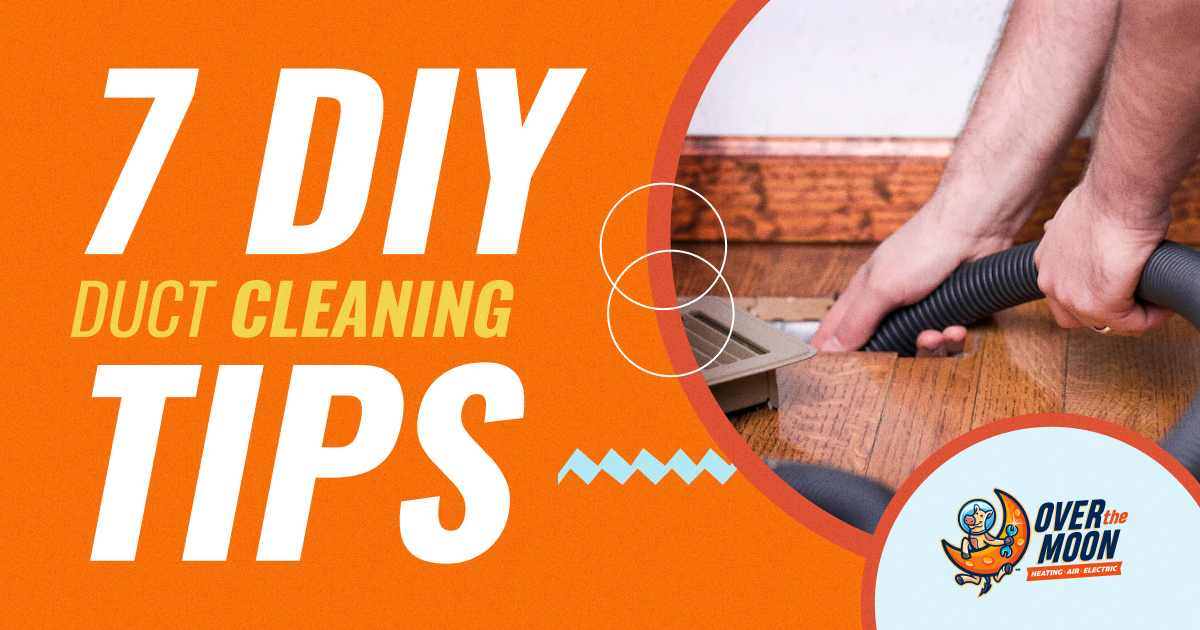Professional duct cleaning requires specialized machinery and equipment. Some DIYers prefer to take on the challenge themselves. With the right supplies, you can clean ductwork yourself, especially if it’s been properly sealed, you’ve changed the air filters as recommended, and the floor registers have been vacuumed every six months. You should consider a DIY or professional duct cleaning if:
- Your home is remodeled or renovated, which creates a lot of dust.
- Sealants and tape on ductwork have noticeably deteriorated.
- The presence of insects, rodents, or animal nests is discovered.
- Routine maintenance hasn’t been performed in a while.
- It’s been three to five years since your ducts were last cleaned.
- Mold growth is found (we recommend hiring a professional to clean it).
Tips for Cleaning Your Air Ducts
Unlike a professional, you can’t reach every corner of your ductwork. The average homeowner can clean up to 10 feet into each duct. However, professional duct cleaning can cost upwards of $1,000, depending on the job, but cleaning ducts on your own can cost as little as $50.1
If you’ve decided to go the DIY route and save money, here are some helpful tips:
- Gather Duct Cleaning Equipment: You’ll need a screwdriver that matches the screws on the vents, a soft bristle brush attached to a long handle, and lots of rags and towels. A vacuum cleaner with a hose attachment can reach into the vents and ducts (we recommend a shop vac for this). And since you’ll likely encounter a substantial amount of dust, protect yourself with gloves, a dust mask, and goggles. You will also need a sturdy ladder.
- Clean the Registers and Grates: If the registers are near the ceiling, climb the ladder, unscrew the grates, and remove them. Some systems place vents on the floor. For floor-mounted grills, just reach down and unscrew them. Cover all the removed panels with rags to avoid spreading dust. The grates can then be wiped clean until no dust remains on their surfaces.
- Turn On the Fan: Airflow alone won’t eliminate all the dirt in your ductwork. But air pressure can help dislodge contaminants. Before you continue, set the thermostat to fan mode or turn on the heat to start the fan.
- Remove Dirt Manually: There are a few ways to clean ducts. The most basic approach is to grab a microfiber cloth and reach into a duct as far as you can. Clean and rinse the cloth as needed and wipe as much of the interior as possible.
- Attach a Chimney Cleaning Head to Nylon Rods: If you have a 10-foot nylon rod, attach a chimney cleaning head to it. Then reach into the supply and return ductwork. An electric drill rotates the chimney head. While it isn’t as powerful as a professional duct cleaning machine, it can be effective if not all surfaces are coated in dirt.
- Run the Drill Forward: Push the cleaning head into the duct. Only 1 foot of it should be exposed. Connect the rod and drill and then press the trigger forward. Do not run it in reverse, as the assembly can come apart in the duct. If you reach a 90-degree turn or tee, direct the rod around the corner. Slowly pull the cleaning rod out while the drill is turning and then shut off the power tool.
- Use a Shop Vac: Wipe up contaminants that have moved to the supply vent. Next, attach the vacuum extension hose. Secure any nozzle you use with duct tape. Turn on the vacuum and force the hose into the supply duct. Reach as far as it’ll go and slowly draw it back, jostling it to reach as much of the vent as you can.
Repeat tips four through seven for the return duct. Then replace the cleaned grates and secure them to the vents. Turn on your HVAC system for about 20 minutes. Then shut it off and examine the air filter. Loose debris not collected may be caught, so discard and replace the filter to avoid airflow issues.
Should I Hire a Professional?
Duct cleaning professionals use a different process that involves applying negative pressure. This moves contaminants toward the main unit. A technician cuts a hole in sheet metal ductwork near the air handler to collect debris and then seals this hole when done. During a DIY duct cleaning, contaminants are pulled toward vents. It can improve indoor air quality and reduce allergies, but only a professional can reach all your ductwork.
Call a contractor if you suspect a significant ductwork leak, your home isn’t heating or cooling, or there are foul and/or musty odors coming from vents.
Call Over the Moon
Over the Moon can provide a whole-home duct cleaning to eliminate odors, improve efficiency, and clean the air in your house. It can prevent illnesses from bacteria, mold, and other disease-causing contaminants (not guaranteed). If your air filter clogs quickly, ductwork is noisy, airflow is restricted, the energy bill has gone up, or you see mold and mildew near vents, call 262-510-0956 for ductwork cleaning services in Brookfield, WI.

